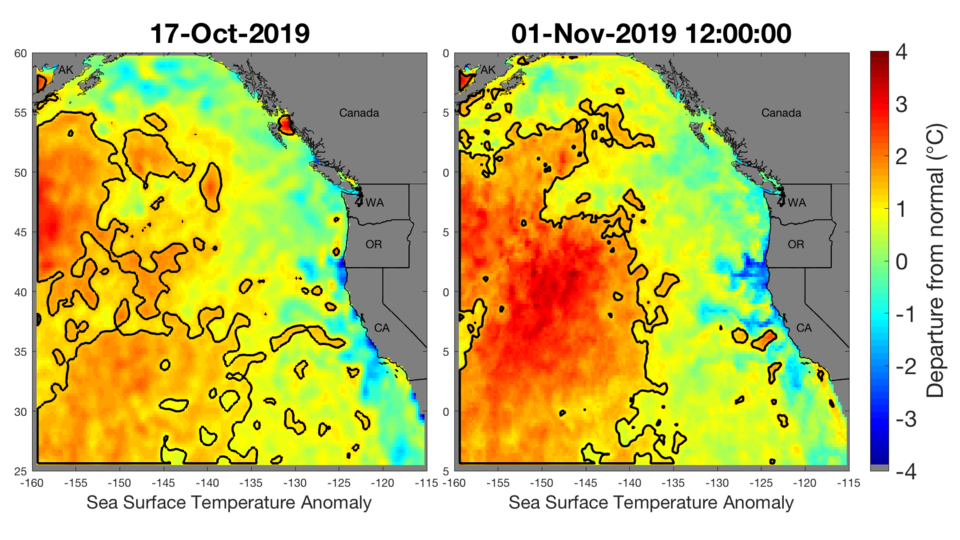Scientists say a marine heatwave that blanketed a large area of the west coast has weakened, but the potential disruption to ocean life isn't over yet.
Nate Mantua of the National Oceanic and Atmospheric Administration said the "good news" is that the area of exceptionally warm water is substantially smaller now than it was earlier this year.
And while the area about 1,500 kilometres offshore between Hawaii and Alaska is still seeing high temperatures by historical standards, it is "simply not nearly as large as it was and it is no longer strong in areas near the west coast," he said.
Scientists have been watching a marine heatwave that developed around June this year and resembled a phenomenon that was nicknamed 'The Blob,' which disrupted ocean life between 2014 and 2016.
The heatwave, which resembles a wedge this time, stretched from south of Vancouver Island to Baja, Calif., and offshore towards Hawaii. It raised temperatures by up to 4 C.
Mantua said "many energetic storms and unusually strong winds from the north off the west coast" have cooled surface waters back to near normal temperatures for much of the region.
"On the other hand, the offshore warming is still in place, and by historical standards, it is still a large marine heatwave," he said in an email.
The latest climate model forecasts from the National Oceanic and Atmospheric Administration's Climate Prediction Center suggest that the offshore warming will gradually weaken over the next seven months, but even by spring will still be warmer than normal, Mantua said.
Prof. Andrew Trites at the University of British Columbia's Institute for the Oceans and Fisheries said the marine heatwave is caused when there is not enough wind to churn and cool the water.
"This past summer winds were very, very light — not strong enough for ocean to be mixed the way it used to be in the past. As a result the ocean didn't cool down the way it was supposed to and it's holding its heat," he said in a phone interview.
"It's not that the ocean got warmer, it's really that the ocean did not get cooler."
As a result, some species of tropical fish that are usually seen in tropical waters were found off the west coast, he said.
"One of the fish that I saw a lot of this summer was the sunfish and presumably they are here in higher numbers because the water here was unusually warm this summer and they can tolerate warm temperatures," Trites said.
 (via NOAA Fisheries)
(via NOAA Fisheries)Mantua said the most obvious impacts included a pattern of unusually low plankton production from July through September from Vancouver Island to northern California.
Warm waters near the coast of northern California, Oregon, and southern Washington brought albacore tuna closer than normal to the coast, and sport fishing was especially good there this summer, he said.
However, ocean salmon fishing in those areas was generally poor, Mantua said.
"All that said, I have not heard of any reported ecosystem impacts in those offshore waters where it remains very warm," he said.
"I suspect that the extreme warming in the productive part of the open ocean has had some impacts, but there simply isn't a lot of information coming from those regions aside from satellite observations of ocean colour that tell us some general information about plankton production."
There is a chance that the marine heatwave might return, Mantua said, although he thinks "the odds for that are low, at least based on the latest climate forecasts."
Trites said the first time this heatwave occurred about five years ago, it was thought that it would never happen again.
"So this may be an example of climate change and global warming. It is changing the patterns of air circulation and affecting storminess and it's not going to mix the water the way it used to."
– Hina Alam, The Canadian Press


